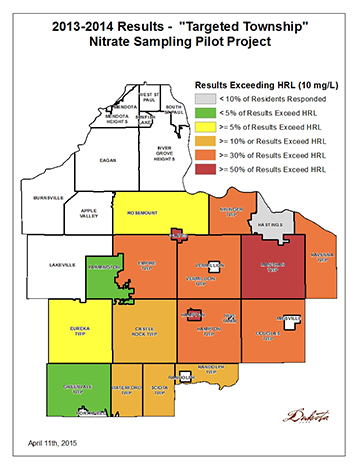Eastern and southern Dakota County have a history of high nitrate in the groundwater and in streams leading to the Vermillion and Cannon rivers. For a number of years, Dakota County has worked with farmers, private well owners, the City of Hastings, Minnesota Department of Agriculture, the Minnesota Pollution Control Agency, Vermillion River Watershed Joint Powers Organization, Dakota County Soil and Water Conservation District, and other partners to reduce the amount of nitrate reaching the water supplies of private well owners and the Hastings municipal water supply.
In 2013 and 2014, related to the Minnesota Department of Agriculture's revision of the statewide Nitrogen Fertilizer Management Plan, Dakota County was a pilot area for the Department of Agriculture's new Township Testing initiative. The revised Fertilizer Plan includes an ambitious effort to identify all parts of the state where more than five percent of the private drinking water wells (per township or city) exceed the drinking water standard for nitrate.
In cooperation with MDA, the county conducted a pilot project to evaluate the effectiveness of collecting nitrate samples from private well owners by mail from the cities of Coates, Farmington, Hampton, Hastings, and Rosemount in addition to all twelve townships. MDA selected these areas based on their soils and geology and the percentage of land used in agriculture.
The county worked with a private lab that handled test kit mailing and sample analysis. Test kits and sample analysis were free to well owners. The lab sent participants their individual results after the sample was received.
The project was funded by grants from the Clean Water, Land & Legacy Amendment.
Contamination worse than expected
The study results were worse than expected. In the study area, 26 percent of the private wells tested exceeded the drinking water standard (Health Risk Limit, or HRL) of 10 milligrams per liter (10 parts per million). In the City of Farmington, none of the private wells exceeded the standard, and in Greenvale Township, 3 percent of wells exceeded the standard. The other communities included in the study all exceeded the MDA threshold of five percent of private drinking water wells over the health standard.
| Castle Rock Twp. |
473 |
101 |
15 |
15% |
| City of Coates |
55 |
11 |
6 |
55% |
| Douglas Twp. |
250 |
68 |
24 |
35% |
| Empire |
220 |
58 |
18 |
31%% |
| Eureka |
525 |
123 |
8 |
7% |
| Farmington |
80 |
18 |
0 |
0% |
| Greenvale |
283 |
58 |
2 |
3% |
| Hampton Twp. and City |
326 |
80 |
24 |
30% |
| City of Hastings |
40 |
2 |
1 |
50% |
| Marshan Twp. |
401 |
115 |
61 |
53% |
| Nininger Twp. |
301 |
88 |
31 |
35% |
| Randolph Twp. |
231 |
55 |
6 |
11% |
| Ravenna Twp. |
804 |
298 |
113 |
38% |
| Rosemount |
528 |
165 |
10 |
6% |
| Sciota Twp. |
121 |
29 |
4 |
14% |
| Vermillion Twp. |
417 |
83 |
37 |
45% |
| Waterford Twp. |
202 |
41 |
11 |
27% |
| Total for Study Area |
5,257 |
1,391 |
370 |
27% |
* Greater than 10 mg per liter.

Cause is likely a combination of factors
The main source of nitrate contamination is likely a combination of nitrogen fertilizer application on porous soils or on land drained by ditching and tiling, and pollutant runoff. Nitrate comes from human and animal wastes, plant decay, and nitrogen fertilizers. When fertilizer is applied to the land in excess of recommended amounts, at the wrong times of the year, or where shallow groundwater is common, the potential for nitrate contamination is much greater. Animal manure or septic systems can also contribute nitrate to water resources.
Surface water and groundwater in Dakota County are linked and their interaction affects drinking water. East of Farmington, where the South Branch tributary of the Vermillion meanders through Castle Rock, Empire, and Vermillion townships, the shallow groundwater carries high nitrate from the farm fields into the South Branch. Downstream, near the City of Vermillion, the Vermillion River's water seeps back into the groundwater aquifers, increasing nitrate in the drinking water supply.
Address the problem at its source
To address the problem at its source, many area farmers have initiated conservation and nutrient management practices, but current efforts are not enough. More widespread adoption of Minnesota Department of Agriculture and University of Minnesota recommended nitrogen management practices, changes in crop rotation, irrigation scheduling, and improved drainage management practices are needed to reduce nitrate. In addition, the Minnesota Department of Agriculture is proposing restrictions on the use of nitrogen fertilizer during the fall or winter.
Financial and technical assistance for farmers interested in practices reducing nitrate is available by calling the Vermillion River Watershed at 952-891-7546 or the Dakota County Soil and Water Conservation District at 651-480-7777. Innovative and alternative practices and treatment options may be denitrifying bioreactors, saturated buffers, cover crops, forage crops, and other land management alternatives on sensitive fields.